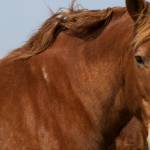Medications Provide Added Protection for Some Horses at Risk of Laminitis

Horses with abnormally high levels of circulating insulin have a markedly increased risk of a specific form of laminitis called hyperinsulinemia-associated laminitis (HAL). Rapidly reducing insulin levels in horses at risk of HAL or currently suffering a bout of laminitis is essential for the horse’s welfare. When diet and exercise alone do not reduce insulin sufficiently, adding a sodium-glucose co-transporter 2 (SGLT2) inhibitor rapidly and markedly improves hyperinsulinemia.
The SGLT2 inhibitors promote glucose excretion by the kidneys. With less glucose in circulation, less insulin is released from the pancreas. A small number of SGLT2 inhibitors are currently available for off-label use in horses, including canagliflozin. This medication is being used clinically with scores of anecdotal reports offering ringing endorsements, yet evidence-based data on canagliflozin’s efficacy are lacking. Further, the safety of this medication remains unproven in horses and ponies.
“Managing hyperinsulinemia can be challenging, so many horse owners would welcome a medication that assists in controlling hyperinsulinemia. This is particularly true for horses that require rapid correction of hyperinsulinemia such as those currently suffering from HAL,” explained Ashley Fowler, Ph.D., a Kentucky Equine Research nutritionist.
The rapid decrease in circulating insulin was recently demonstrated in a Swedish study using 16 client-owned horses. All horses were diagnosed with insulin dysregulation, defined as insulin concentrations greater than 100 mIU/mL 60 to 90 minutes after sugar consumption. Half of the horses were then treated with 0.6 mg/kg body weight canagliflozin once daily at 9:00 p.m. or a placebo for three weeks.*
Data collected during the study confirmed that canagliflozin decreased the body’s response to sugar. Specifically, the average hyperinsulinemic response was decreased by over 66% compared to the placebo group. This means that the insulin levels were markedly decreased following glucose administration during an oral sugar test. The researchers deemed this a “very efficient” treatment effect.
To temper enthusiasm, however, the research team also noted that despite the improvement, only 50% of the treated horses had normal insulin concentrations following the oral sugar test.
“In terms of safety, canagliflozin was well tolerated in all horses; however, triglycerides were elevated in treated horses. Higher levels of triglycerides may have been related to an increased weight loss (triglycerides mobilized from the body’s fat stores) in the treated group, but there was not a statistically significant relationship between those two variables. More information is needed to determine the cause of the elevation in triglycerides,” Fowler said.
Of note, horses included in this study were fed hay or haylage with a low nonstructural carbohydrate (NSC) content.
“Feeding a diet with low NSC is a recommended feeding strategy for horses with insulin dysregulation and hyperinsulinemia because large amounts of NSC can increase blood glucose and further exacerbate already high insulin levels,” explained Fowler.
While preliminary results on the SGLT2 inhibitors are positive, experts warn the equine community that medication is a second line of defense.
“Avoiding or correcting obesity through diet and exercise rather than relying on the SGLT2 inhibitors is strongly encouraged. For horses with insulin dysregulation, keep NSC intake low by avoiding high-grain feeds (choose products that contain low-NSC ingredients such as fats, beet pulp, and soy hulls), limiting sugary treats, and sourcing low (less than 10%) NSC hay. For easy keepers, a forage-only diet is unlikely to meet all requirements for minerals and vitamins, so make sure to add in a ration balancer or low-intake vitamin-mineral supplement. If the horse is sound, adding in exercise can also help control hyperinsulinemia,” Fowler advised.
Additional studies on the long-term safety and optimal dosing of canagliflozin are needed. That said, the research team did conclude that the SGLT2 inhibitors appear to be the “most efficient pharmacological treatment in decreasing the insulin response to oral sugars in insulin dysregulated horses.”
In the United Kingdom and Australia, the SGLT2i ertugliflozin is gaining popularity for managing hyperinsulinemia. According to one study, ertugliflozin has likely been used in hundreds of horses to date and appears quite promising based on a case series of 51 horses and ponies with persistent hyperinsulinemia.**
*Lindåse, S., K. Nostell, A. Forslund, P. Bergsten, and J. Bröjer. 2023. Short-term effects of canagliflozin on glucose and insulin responses in insulin dysregulated horses: A randomized, placebo-controlled, double-blind, study. Journal of Veterinary Internal Medicine 37(6):2520-2528.
**Sundra, T., E. Kelty, and D. Rendle. 2022. Preliminary observations on the use of ertugliflozin in the management of hyperinsulinaemia and laminitis in 51 horses: A case series. Equine Veterinary Education. doi:10.1111/eve.13738.








